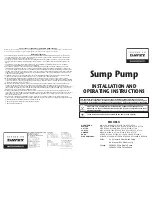
Rotary Tool
4
For technical questions call: 1-800-665-8685
8352965
V 3.02
SPECIFIC SAFETY PRECAUTIONS
1. Keep hands and fingers away from grinding area. Any part of body coming in contact with
moving parts could cause injury.
2. When operating the rotary tool, use proper eye, breathing and hearing protection as well as
protective gloves.
WARNING! Flying debris can cause permanent eye damage. Prescription eyeglasses are not a
replacement for proper eye protection.
3. Use protective gloves that will reduce vibration and protect your hands in case of
unexpected situations.
4. To maintain complete control, firmly hold your rotary tool with both hands. Do not place hands
over air vents. Proper cooling of the motor is necessary to ensure normal life of the tool.
5. Never point the cutter towards yourself. If it should slip, part of your body could come in
contact with moving parts.
6. Never force the tool. Excessive pressure could bend or break the mandrel, resulting in damage
to the tool, your work piece or serious personal injury. If your rotary tool runs smoothly under
no load, but does not run smoothly under load, then excessive pressure is being used.
7. This tool will not stop moving immediately. Do not lay the tool down or leave it unattended
until it has come to a complete stop. A part that is moving could make the tool jump or grab a
surface and pull the tool out of your control.
8. Hold the tool by the insulated gripping surfaces when performing an operation where the
cutting tool may contact hidden wiring or its own cord. Contact with a “live” wire will make
exposed metal parts of the tool “live” and shock the operator.
9. Use an appropriate dust respirator when working for an extended period of time. This will help
prevent breathing in the fine dust created while working.
WARNING! Dust that is created by power sanding, sawing, grinding, drilling, and other construction
activities may contain chemicals that are known to cause cancer, birth defects, or other genetic
abnormalities. The level of risk from exposure to these chemicals varies, according to how often this
type of work is performed. In order to reduce exposure to these chemicals, work in a well-ventilated
area, and use approved safety equipment, such as a dust mask that is specifically designed to filter
out microscopic particles.
10. Always make sure the work surface is free from nails and other foreign objects. Cutting into a
nail can cause the bit and tool to jump and damage the bit.
11. After changing the bits and accessories or making adjustments, make sure the collet nut and
any other adjustment devices are securely tightened. Loose adjustment devices will be
violently thrown.
12. Remove any adjusting keys or wrenches before turning the power tool on.
13. Always use the correct collet size. If the collet size is larger than the accessory shank size it will
not grip the shank properly, leading to possible injury to the operator, damage to the tool or
work piece.
14. Always check accessory bits, grinding stones, cut-off wheels etc. for damage before each use.
Damaged accessories can break during use and cause serious injury.
15. Never use dull or damaged bits. Sharp bits must be handled with care. Damaged bits can snap
during use. Dull bits require more force to push the tool, possibly causing the bit to break.





































